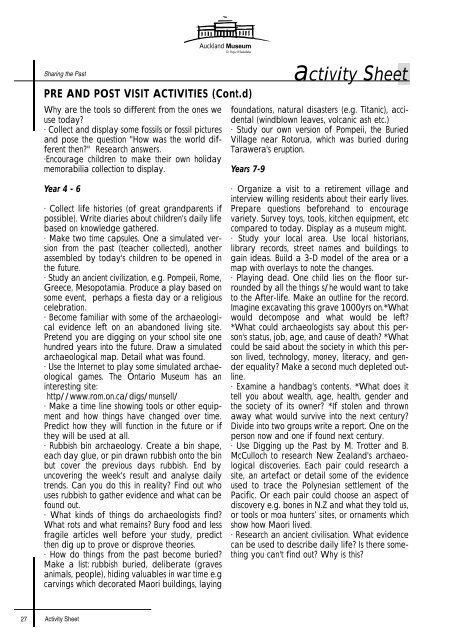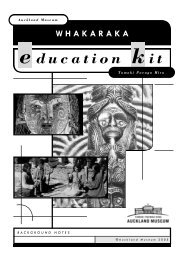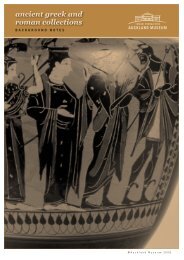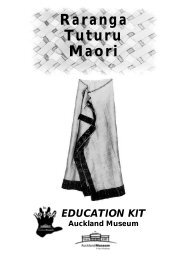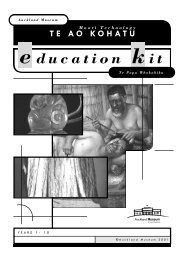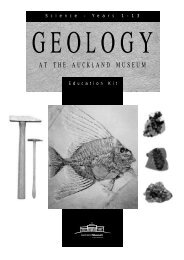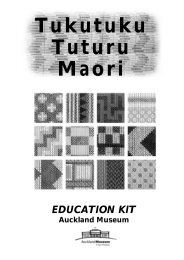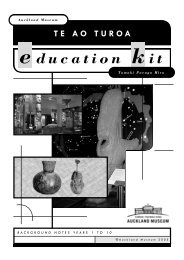Create successful ePaper yourself
Turn your PDF publications into a flip-book with our unique Google optimized e-Paper software.
Sharing <strong>the</strong> Past activity sheet<br />
Why are <strong>the</strong> tools so different from <strong>the</strong> ones we<br />
use today?<br />
· Collect and display some fossils or fossil pictures<br />
and pose <strong>the</strong> question "How was <strong>the</strong> world different<br />
<strong>the</strong>n?" Research answers.<br />
·Encourage children to make <strong>the</strong>ir own holiday<br />
memorabilia collection to display.<br />
Year 4 - 6<br />
· Collect life histories (of great grandparents if<br />
possible). Write diaries about children's daily life<br />
based on knowledge ga<strong>the</strong>red.<br />
· Make two time capsules. One a simulated version<br />
from <strong>the</strong> <strong>past</strong> (teacher collected), ano<strong>the</strong>r<br />
assembled by today's children to be opened in<br />
<strong>the</strong> future.<br />
· Study an ancient civilization, e.g. Pompeii, Rome,<br />
Greece, Mesopotamia. Produce a play based on<br />
some event, perhaps a fiesta day or a religious<br />
celebration.<br />
· Become familiar with some of <strong>the</strong> archaeological<br />
evidence left on an abandoned living site.<br />
Pretend you are digging on your school site one<br />
hundred years into <strong>the</strong> future. Draw a simulated<br />
archaeological map. Detail what was found.<br />
· Use <strong>the</strong> Internet to play some simulated archaeological<br />
games. The Ontario <strong>Museum</strong> has an<br />
interesting site:<br />
http//www.rom.on.ca/digs/munsell/<br />
· Make a time line showing tools or o<strong>the</strong>r equipment<br />
and how things have changed over time.<br />
Predict how <strong>the</strong>y will function in <strong>the</strong> future or if<br />
<strong>the</strong>y will be used at all.<br />
· Rubbish bin archaeology. Create a bin shape,<br />
each day glue, or pin drawn rubbish onto <strong>the</strong> bin<br />
but cover <strong>the</strong> previous days rubbish. End by<br />
uncovering <strong>the</strong> week's result and analyse daily<br />
trends. Can you do this in reality? Find out who<br />
uses rubbish to ga<strong>the</strong>r evidence and what can be<br />
found out.<br />
· What kinds of things do archaeologists find?<br />
What rots and what remains? Bury food and less<br />
fragile articles well before your study, predict<br />
<strong>the</strong>n dig up to prove or disprove <strong>the</strong>ories.<br />
· How do things from <strong>the</strong> <strong>past</strong> become buried?<br />
Make a list: rubbish buried, deliberate (graves<br />
animals, people), hiding valuables in war time e.g<br />
carvings which decorated Maori buildings, laying<br />
27 Activity Sheet<br />
<strong>Auckland</strong> <strong>Museum</strong><br />
Te Papa Whakahiku<br />
PRE AND POST VISIT ACTIVITIES (Cont.d)<br />
foundations, natural disasters (e.g. Titanic), accidental<br />
(windblown leaves, volcanic ash etc.)<br />
· Study our own version of Pompeii, <strong>the</strong> Buried<br />
Village near Rotorua, which was buried during<br />
Tarawera's eruption.<br />
Years 7-9<br />
· Organize a visit to a retirement village and<br />
interview willing residents about <strong>the</strong>ir early lives.<br />
Prepare questions beforehand to encourage<br />
variety. Survey toys, tools, kitchen equipment, etc<br />
compared to today. Display as a museum might.<br />
· Study your local area. Use local historians,<br />
library records, street names and buildings to<br />
gain ideas. Build a 3-D model of <strong>the</strong> area or a<br />
map with overlays to note <strong>the</strong> changes.<br />
· Playing dead. One child lies on <strong>the</strong> floor surrounded<br />
by all <strong>the</strong> things s/he would want to take<br />
to <strong>the</strong> After-life. Make an outline for <strong>the</strong> record.<br />
Imagine excavating this grave 1000yrs on.*What<br />
would decompose and what would be left?<br />
*What could archaeologists say about this person's<br />
status, job, age, and cause of death? *What<br />
could be said about <strong>the</strong> society in which this person<br />
lived, technology, money, literacy, and gender<br />
equality? Make a second much depleted outline.<br />
· Examine a handbag's contents. *What does it<br />
tell you about wealth, age, health, gender and<br />
<strong>the</strong> society of its owner? *If stolen and thrown<br />
away what would survive into <strong>the</strong> next century?<br />
Divide into two groups write a report. One on <strong>the</strong><br />
person now and one if found next century.<br />
· Use Digging up <strong>the</strong> Past by M. Trotter and B.<br />
McCulloch to research New Zealand's archaeological<br />
discoveries. Each pair could research a<br />
site, an artefact or detail some of <strong>the</strong> evidence<br />
used to trace <strong>the</strong> Polynesian settlement of <strong>the</strong><br />
Pacific. Or each pair could choose an aspect of<br />
discovery e.g. bones in N.Z and what <strong>the</strong>y told us,<br />
or tools or moa hunters’ sites, or ornaments which<br />
show how Maori lived.<br />
· Research an ancient civilisation. What evidence<br />
can be used to describe daily life? Is <strong>the</strong>re something<br />
you can't find out? Why is this?


